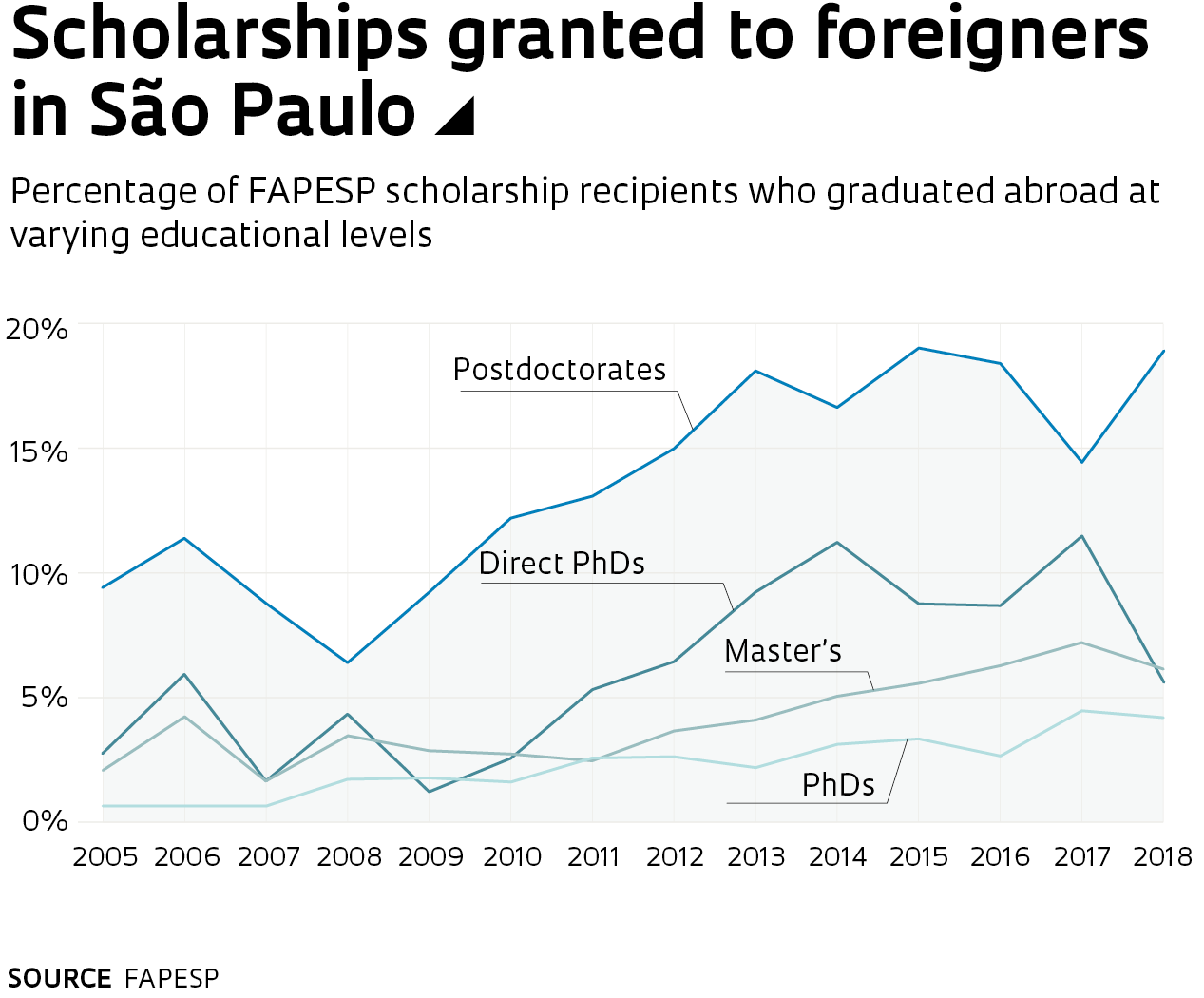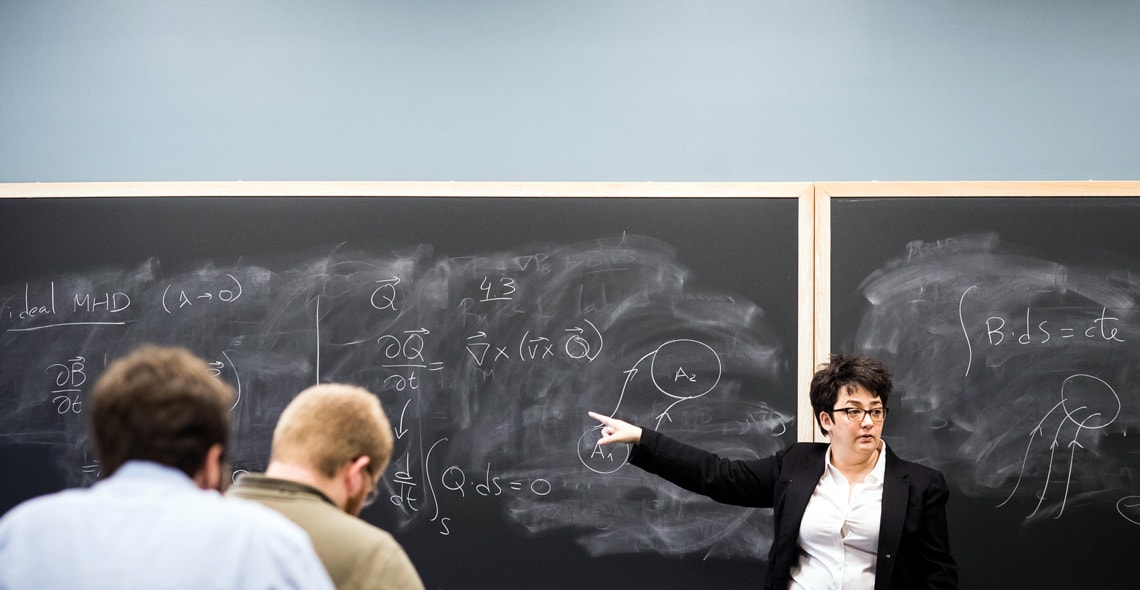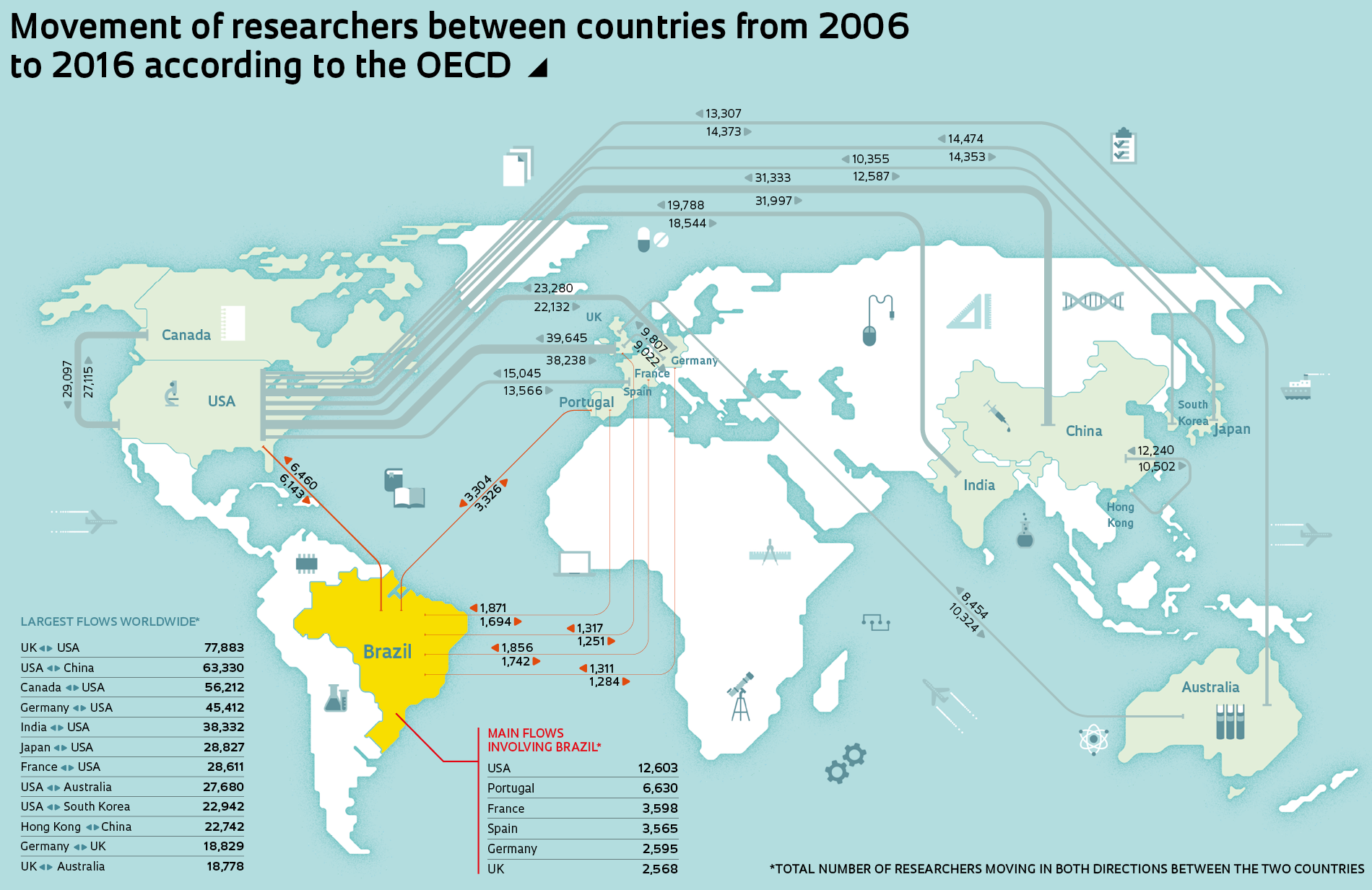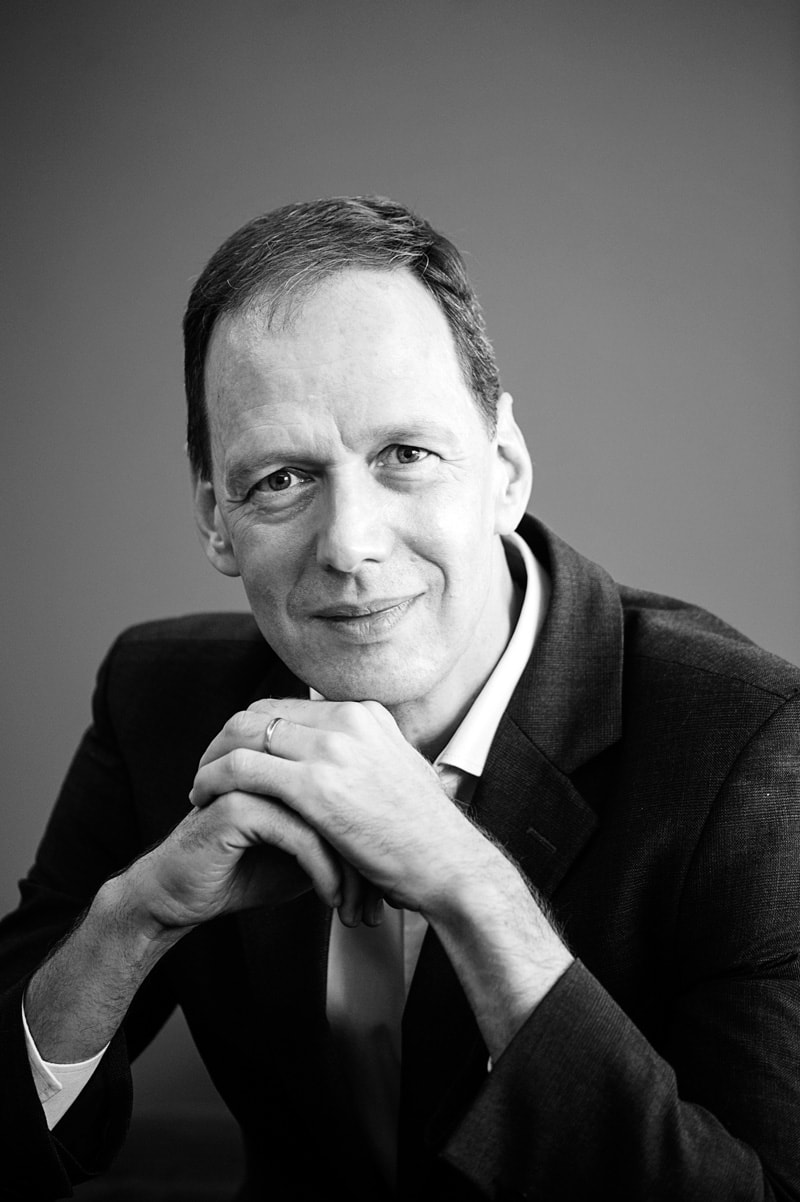In Brazil, especially in times of economic downturn, the risk of losing scientific talent to more developed nations and compromising the country’s capacity for development is a commonly discussed issue. Although there have been no surveys of exactly how many researchers are leaving the country, the information available suggests that the number of Brazilian scientists moving abroad has always been modest compared to other nations—and there is no sign that emigration is increasing due to the funding crisis faced by science in the last five years. Data published in the report Science, Technology and Industry Scoreboard by the Organisation for Economic Cooperation and Development (OECD) in 2017 indicates that in recent years, the flow of scientists moving between Brazil and other countries has remained balanced in both directions, with the country proving itself more than capable of attracting scientific talent.
The OECD examined millions of scientific articles in the Scopus database published between 2006 and 2016, analyzing the career paths of their authors. The study focused on those who moved to a new country at least once in the 10-year period, which was identified based on which institution they were affiliated with when publishing a paper. The results show that immigration and emigration of researchers into and out of Brazil remained low and stable. A contingent of 6,460 scientists living in the country in 2006 had moved to the USA by 2016, while 6,143 went the other way. This is a much lower rate than observed in China, where 32,000 researchers moved to the USA over the 10 years and a similar number took the opposite route, or in India, where 20,000 researchers relocated. When it comes to Europe, the flow toward Brazil is actually higher than vice versa: 1,742 scientists left the country for France, and 1,856 took the opposite route; 1,284 researchers moved from Brazil to Germany, while 1,311 made the opposite move.
The OECD data highlights trends, but the figures should not be taken as absolute. The institution with which an author is affiliated is an indirect way of observing mobility and does not identify scientists who emigrated but did not publish papers in two different places in the period. The statistics do not provide categorical evidence of losses or gains in human capital either, since the research did not look at where the authors graduated or whether they left with the intention of returning—as well as not considering data since 2016. Despite these flaws, the figures are consistent with surveys conducted in previous decades, which showed only a small outflow of scientists from Brazil. A study led by sociologist Simon Schwartzman in 1972 found that the country had a low level of brain drain: only 5% of Brazilians who completed their studies abroad remained there to work. “Brazil has historically had very little international talent circulation, and until recently there was no evidence of a brain drain situation to worry about. The main problem, in fact, was isolation,” summarizes Schwartzman.
In the academic environment, however, there is growing concern that the current science funding crisis may have a greater effect than in previous such periods. Physicist Luiz Davidovich, president of the Brazilian Academy of Sciences (ABC), says he has never received so many requests for letters of recommendation from researchers interested in working overseas. At the Institute of Physics of the Federal University of Rio de Janeiro (UFRJ), where he works, four young researchers have recently left to work at universities or companies in Australia, the Netherlands, Portugal, and Chile. Davidovich says that since the beginning of the year, he has written about 10 letters of recommendation, mostly for researchers at public universities in Rio. “They have learned everything here and now they are going abroad because of the lack of work opportunities in Brazil,” he says. According to the physicist, these scientists have extensive teaching and research experience, were appointed through competitive processes, and their jobs at the institutions where they work are stable.
267,000 Brazilians with a higher education lived in OECD countries in 2011
Political scientist Elizabeth Balbachevsky, from the School of Philosophy, Languages and Literature, and Human Sciences of the University of São Paulo (FFLCH-USP), believes a greater number of highly educated Brazilians are moving abroad, some to study at foreign universities and others with dual citizenship looking for academic or work opportunities. But the international movement of researchers, which has always occurred, is less sensitive to short-term impacts. “Brazil has an education, research, and graduate system that has provided stable and favorable conditions for advanced science in recent decades, something which is not easy to find abroad, where competition is high,” she says. According to Luiz Davidovich, this used to be a major factor in keeping scientists in Brazil. “More recently, however, I’ve noticed more people willing to give up these conditions to move to foreign institutions with no plans to return.”
Getting permission to work as a researcher abroad, however, is not a trivial task. The difficulties many face was highlighted in 2016, when master’s and PhD students receiving grants from the Brazilian Federal Agency for Support and Evaluation of Graduate Education (CAPES) began to pressure the agency to relax its return rules—grant recipients must return to Brazil within 60 days of graduating abroad and then stay in Brazil for a period equal to the time spent overseas. Just 2% of researchers break this contract and refuse to return, usually having been offered highly promising job opportunities. In these cases, they have to repay the investment made by the federal agency. With the lack of academic work prospects in Brazil, grant recipients argue that they should be permitted to stay abroad for longer. In October 2016, CAPES published a decree allowing scientists to extend their stay overseas if they present a research project that includes collaboration with Brazilian institutions. But of the 74 projects submitted, just two met the agency’s stringent requirements. Most of the proposals were submitted by recent PhD graduates who do not have the experience needed to organize a project in collaboration with their host universities.
More experienced researchers have a greater chance of success, as was the case for zoologist Alexandre Aleixo, who left the Emílio Goeldi Museum of Pará in Belém last February after searching for opportunities abroad. He accepted a position as a researcher at the University of Helsinki in Finland. Aleixo studied his undergraduate and master’s degrees at the University of Campinas (UNICAMP) and then moved to the USA in 1997 to do a PhD at the University of Louisiana. He returned to Brazil in 2002 and took part in a competitive application process, through which he earned his position as a researcher at the Emílio Goeldi Museum. “I worked on many management plans for the creation and maintenance of conservation areas in the Amazon,” he says. In recent years, he grew dissatisfied. “I began to find it difficult to conduct cutting-edge research because of the lack of resources, and from a personal point of view, I was unhappy with the level of violence in Belém.” He began applying for posts in early 2018, and in September that year he found success at Helsinki. He is enthusiastic about the new job, but remains open to the possibility of one day returning. Instead of resigning from his post at the museum, he took a leave of absence that can last up to six years.
70,000 Brazilians with a higher education lived in the USA in 2010
International diasporas
In academic literature, the movement of highly qualified scientists from one country to another in search of job opportunities or driven by political and economic crises is known as a “scientific diaspora.” China and India have seen major exoduses of scientific talent. Based on data on foreign graduates working in the OECD nations—comprising the 36 most industrialized nations in the world—India topped a 2011 survey, with 2 million expatriates, followed by China with 1.6 million, and the Philippines with 1.4 million. According to the survey, 267,000 Brazilians with a higher education were living in these countries, less than the number from Japan (371,000) and Vietnam (524,000).
When including citizens of all educational levels, the Brazilian Ministry of Foreign Affairs estimates that there are between 2 million and 4 million Brazilians living abroad. “It’s normal for people to look overseas in times of economic crisis. In Brazil, waves of emigration have already happened in the 1960s and 1990s, and now there is another one in progress,” says sociologist Ana Maria Carneiro, a researcher at UNICAMP’s Center for Public Policy Studies. She is coordinating a research project, currently in the early stages of development, that aims to understand the career paths of Brazilian scientists based in the USA and their motivations for leaving Brazil. “The objective is to propose policies that can utilize highly qualified Brazilians who have moved to and settled in the USA to improve Brazilian science,” she explains, referring to evidence that in many places, rather than a brain drain, diaspora networks can actually create useful connections for the scientific community in their home country.
According to a census conducted in the USA in 2010, there were 70,000 Brazilians with a higher education living in the country, although the data does not show how many of them are working as researchers. Carneiro’s project, which aims to shed light on this matter, results from a request by the Brazilian embassy in Washington, which in 2017 identified 20 groups of Brazilian scientists working in the USA, mostly in California and the New England region. They often meet to exchange scientific and entrepreneurial experiences. The research team is also preparing to study the Brazilian scientific diaspora in the UK, which is smaller than the North American contingent.
Rather than fearing brain drain, many countries see the emigration of scientists as an opportunity. “China and India treat researchers who have settled overseas as a strategic link that they can use to foster scientific collaboration and help introduce their industries to the US market. In Brazil, we have never mobilized our migrants,” says Balbachevsky. “Maybe the country is wrong to try to bring so many people back. If more researchers stayed abroad, they could help build bridges with Brazilian science and invite more Brazilian students to learn from their groups.”
India’s Ministry of Science and Technology routinely engages scientists living abroad in its initiatives, asking them to evaluate research proposals and oversee studies. In Taiwan, the emergence of a venture capital industry in the 1980s was directly supported by natives of the Chinese island who had migrated to Silicon Valley in the USA—many of them returned to start businesses with government support and share their expertise. South Korea incorporated contributions by expatriate talent into its own development agenda, an approach that Argentina and Mexico are trying to repeat, with limited results so far.
Even Chile, which like Brazil has seen a relatively small number of researchers moving abroad, has benefited from their experience: the creation of technology companies in the country has been strongly influenced since the late 1990s by US-based Chileans with advanced scientific and entrepreneurial knowledge. “Diaspora members can serve as antennas to detect better performing and more dynamic segments of domestic institutions and as institutional vehicles to expand these segments,” wrote economist Yevgeny Kuznetsov, from the Migration Policy Institute in the USA, in the book How Can Talent Abroad Induce Development at Home? (Migration Policy Institute, 2013), which analyzes the examples cited above. In Kuznetsov’s assessment, the countries most successful in harnessing the contribution of their citizens abroad were those that organized diaspora leadership groups, facilitated their interaction with local agencies, supported high-quality projects with well-defined objectives, and focused on entrepreneurship.

Chinese exodus
For a long time, the Chinese migrated en masse to study abroad, mainly in the USA and Europe. In 2008 alone, some 180,000 of them left their country, 25% more than the previous year. “In recent years, however, the Chinese have created initiatives to bring back scientists, entrepreneurs, and other highly qualified experts from around the world,” says climatologist Carlos Nobre, former president of CAPES. The objective, he says, was to invest in robust science supported by international networks as a foundation for its development plan. Data from the OECD report indicates that China, by allowing some scientists to remain abroad and bringing back others, nearly doubled the proportion of international scientific collaborations in which it was involved between 2005 and 2015—from 7.4% to 12.2% of all published articles.
Since the early 2000s, the debate on scientific diaspora and its global and regional effects has resumed, with a new focus on the positive effects these processes can have by mobilizing international networks and collaborations. According to Ana Carneiro, this new approach goes against the idea of “brain drain” by suggesting two other migratory models to describe academic movement: brain circulation and the brain network. “These concepts are connected in the sense that members of scientific diasporas, even from a far distance, can influence institutions in their home country to build international research networks,” explains the sociologist.
6,100 researchers left the USA for Brazil between 2006 and 2016, according to OECD data
A study published in the journal Nature in 2017 evaluated 14 million articles published by millions of scientists between 2008 and 2015. It found that articles with authors from more than one country—which were therefore disseminated across different academic institutions and cultures—had a 40% higher citation rate on average than those whose authors were all from the same country. “Researchers in positions of leadership abroad can enrich the experience of their national scientific community, especially in areas considered essential to the country’s development,” says physicist Eduardo Couto e Silva, director of the National Biorenewables Laboratory at the National Energy and Materials Research Center (LNBR-CNPEM) in Campinas, who previously worked abroad at scientific institutions in Switzerland and the USA, before deciding to return to Brazil 10 years ago.
Scientists based abroad are usually willing and interested in maintaining ties with their home country. This is what Brazilian biologist Jair Siqueira-Neto has done, a professor at the University of California, San Diego, in the USA. Siqueira-Neto has been working in the US since 2014, after a spell at the Institut Pasteur in Seoul, South Korea. “Since then, I have co-supervised Brazilian students and established several research collaborations with universities in Brazil.”
A recent attempt to increase the mobility of Brazilian students and researchers was ended before its impact could be assessed after being deemed too expensive. The Science Without Borders (CsF) program was launched in 2011 with ambitions to send over 100,000 undergraduate and graduate students to study abroad. In total, 92,880 scholarships were provided by 2016, mostly for undergraduate sandwich programs. According to Concepta Margaret Pimentel, former director of international relations at CAPES, the goal was also to attract talent from abroad, but the result was largely unsuccessful. Science Without Borders intended to award 2,000 scholarships to visiting scientists, but less than half of that number were actually given, as few people were interested in coming to Brazil under the conditions on offer.

Pimentel believes that one of the mistakes the CsF program made was focusing on the quantity of students sent abroad rather than quality. “The decree was issued, and we had just a short time to send more than 100,000 people overseas, as well as somehow attracting foreign talent to come here. To do this, you need contacts, you need to build networks with researchers and institutions from other nations,” she says. “The program would have been more effective if it had focused on graduate studies, where knowledge is produced.” To replace it, CAPES launched the Institutional Program for Internationalization of Brazilian Universities (PRINT) in 2017 with the aim of fostering international partnerships in master’s and PhD programs. At the end of last year, CAPES released the list of 36 institutions chosen to participate in the program, which will receive federal funding to create strategic internationalization plans for their teaching and research activities. Whatever approach Brazil adopts, its impacts will depend on the domestic academic environment being provided with the research infrastructure and funding it needs.
 Jackie Ricciardi / Boston UniversityBrazilian astrophysicist Merav Opher (photo) has lived in the USA for almost two decades. She promotes exchanges for researchers and graduate students between various institutions in Brazil and the Department of Astronomy at Boston University, where she has been working since 2015. She welcomes sandwich students and researchers on postdoctoral fellowships.
Jackie Ricciardi / Boston UniversityBrazilian astrophysicist Merav Opher (photo) has lived in the USA for almost two decades. She promotes exchanges for researchers and graduate students between various institutions in Brazil and the Department of Astronomy at Boston University, where she has been working since 2015. She welcomes sandwich students and researchers on postdoctoral fellowships.
Opher often visits Brazil to give lectures and seminars. More recently, however, she has begun working with Mackenzie Presbyterian University in São Paulo to create an international school of space physics in the city. The idea is to connect Brazilian students and researchers to international researchers and scientists who work in the field, without having to leave the country. She explains that space physics is still an incipient field in Brazil. “I went to the US in 1999 to do a postdoctoral fellowship because I couldn’t find anywhere in Brazil where I could improve myself in this field.” The astrophysicist left the country with no intention of returning. She has worked at some of the USA’s leading research institutions, including NASA’s Jet Propulsion Laboratory, the California Institute of Technology (CalTech), and George Mason University, a public research university in the state of Virginia. She says that space physics has grown in stature in recent years due to the discovery of so-called exoplanets—planets orbiting other stars outside our solar system. Opher believes Brazil can benefit from Brazilian researchers working overseas and the training they receive there, using their experiences to improve how scientists are taught in the country.
Unlike in Brazil, where most scientists spend their entire academic lives at the same institution, research careers in the USA and Europe are generally more dynamic. The career path of Brazilian physician Antonio Bianco (photo), who graduated from the Santa Casa School of Medicine in São Paulo in 1983 and earned his master’s degree, PhD, and teaching postdoc at the USP Institute of Biomedical Sciences (ICB-USP), demonstrates this difference well. His first experience abroad was during his PhD, when he spent a sandwich period at Harvard University in the USA. “I came back to Brazil in 1986, completed my PhD, and was hired as a professor at ICB-USP,” he recalls. “But I kept thinking about going back.”
Years later, Bianco’s plan to leave the country became a reality. “I went back to Boston in 1998, as a visiting professor at Harvard Medical School, and then an associate professor,” he says. He spent 10 years at Harvard. In 2008, he was offered a position as head of endocrinology at the University of Miami. The experience helped him hone his skills in the administrative side of academic medicine. “I spent six years in Miami, and then I was offered the role of executive vice dean of Rush University’s Department of Medicine in Chicago.” Bianco was then named president of the university’s medical group in 2015. “It was a fantastic experience, but it left little time for research. So I chose to go back to teaching and lab work.” In 2018, he became a professor at the University of Chicago. Bianco says moving around so much has helped his career because it allowed him to experience different challenges at every institution he worked at.
Moving to another country, however, can be complicated even for the most experienced scientists. “If I had known how difficult it would be to establish myself as a researcher in the US, I might have thought twice about coming,” says Bianco, who has lived there since 1998. He explains that university teaching positions and research funding are highly competitive under the American system. “Even established researchers don’t have an easy life,” he says. As a result, many foreigners struggle to adapt, and end up returning to their home country. Others spend years on successive postdoctoral fellowships at renowned research labs. “In addition, foreign scientists in the United States can only apply for funding from the National Institutes of Health [NIH] if they have a permanent residence visa, which can take years to obtain,” he says. And even those with a residence visa are not guaranteed funding.
German scientist Klaus Capelle (photo), an expert in condensed matter and quantum chemistry, arrived in Brazil 22 years ago, going on to develop his career as a researcher and academic administrator: he was a professor at USP, dean of the Federal University of ABC (UFABC) between 2014 and 2018, and now works at the National Energy and Materials Research Center (CNPEM). Capelle has a degree in physics from the University of Würzburg in Bavaria, where he also studied his master’s and PhD, before earning a scholarship for a postdoctoral fellowship at USP’s São Carlos Institute of Physics in 1997, originally to spend a year under the supervision of physicist Luiz Nunes de Oliveira. He ended up putting down roots in Brazil.
From 1999 to 2003, he was funded by the FAPESP Young Researchers in Emerging Centers program, establishing a research group at USP’s São Carlos Institute of Chemistry. In the following years, he spent time as a visiting researcher at the universities of Missouri (United States) and Bristol (United Kingdom), among others. He was offered permanent positions in Germany and the UK, but chose to stay in Brazil. “I was excited by the idea of building something new, which wouldn’t be possible in Europe,” says Capelle, who was a professor at USP between 2003 and 2009 before leaving the institution to work at UFABC, where he became vice dean in 2010 and dean in 2013. He has been working at CNPEM in Campinas since 2018.
For now, Capelle does not expect greater numbers of researchers to leave Brazil than in the past, but he refuses to rule out the possibility in the future, and warns of another danger caused by the current crisis: a reluctance among foreign scientists to coming to Brazil as permanent or visiting researchers. “A decreasing number of foreign scientists coming to Brazil, as well as concerns at foreign institutions about the lack of Brazilian involvement in collaborative programs, could compromise Brazilian science as much as a brain drain,” he says.
Encouraging researchers like Capelle to settle in the country is one of the goals of the Young Researchers program, which funds the formation of groups led by scientists with high potential and the international experience needed to implement globally competitive lines of research. The program offers a grant that guarantees funding for recipients to set up their laboratories. For researchers not employed by an institution, FAPESP offers a scholarship similar to a postdoctoral fellowship. The intention is to help them prepare to later apply for a position at the same university. Of the nearly 1,600 scientists who have benefited from the program since 1995, 9.4% graduated abroad. Other grants offered by the foundation also attract foreign researchers. Of the 694 postdoctoral fellowships awarded by FAPESP in 2018, 18.8% went to foreigners, with special mention to the exact and earth sciences, where the percentage of overseas recipients was 32%.


